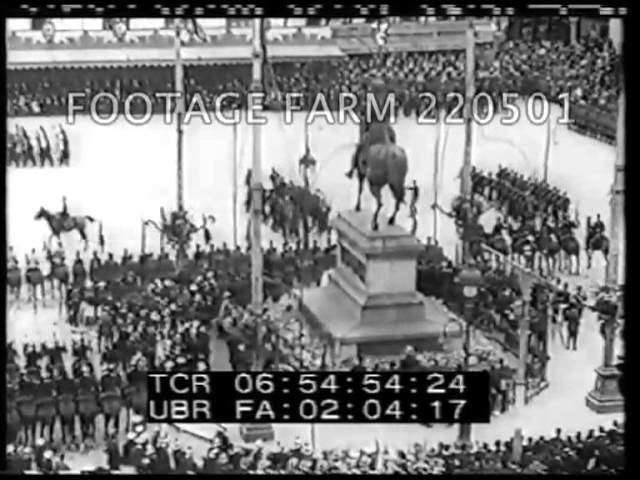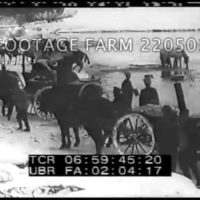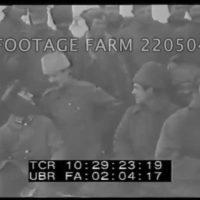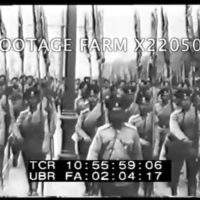
Related

1914 Russian various 220502-11 | Footage Farm

1914 - WWI, Preparations in France & Russia 220494 09 | Footage Farm

1914 Russian Hospital & Wounded 220497-08 | Footage Farm

Russian Troops World War One 220501-12 | Footage Farm

1910s - Russian Winter, Open cars driving & racing on ice 220496-02 | Footage Farm

1910s - Russian Sports Events 220498-09 | Footage Farm

1911 Russia Various 220496-06 | Footage Farm

WWI Russian Troops 220504-07 | Footage Farm

WWI - Russian Military Preparation & Fighting 220504-11X | Footage Farm
1914 - Russian Riding Competition; Saint Augustine Fire 220501-11 | Footage Farm
Summary
For broadcast quality material of this reel or for more information about our Public Domain collection, contact us at info@footagefarm.co.uk
[1914 - Russian Riding Competition; Early Aviation Stunts; Religious Funeral; Saint Augustine Fire]
Russian Main Title:
06:51:33 Inter-title: Moscow - Gymkhana - horse jumping poles, barriers, low brush & gates at outdoor competition on wooded course. Spectators around edges. Winners posing
06:52:30 Russian Inter-title: St. Petersburg - Pilot Yankovsky flying over field, stunting, aircraft landing - very early flight - people pose in front of plan (woman pilot?).
06:53:23 Russian Inter-title: Kiev -
06:53:31 Religious icons carried / paraded around streets, military lining route; people watching from behind - top shot religious procession. Into church or monastery. GOOD.
06:54:06 Russian Inter-title: Italy - Reze ??
06:54:12 Funeral cortege of an artist - Coffin in ornate horse drawn carriage surrounded by crowds,
06:54:27 Russian Inter-title: Orleans, France ??
06:54:36 Parade in honor or Joan of Arc - VIPs in top hats lead military parade thru streets, pass in front of statue of St. Joan in large square.
06:55:19 Russian Inter-title: America - Saint-Augustine (02Apr14 (?) fire destroying much of the bay-front -aftermath).
06:55:26 Russian Inter-title: ??
06:55:31 High angle of aftermath of fire that destroyed much of city waterfront; pan over smoking ruins of buildings. LS smoke rising above distant trees.
06:56:00 Early airplane climbing after takeoff. Seen landing (?); in flight swooping. & stunting doing vertical rolls, looping the loop.
06:57:16 Monoplane taxiing; group pose as at beginning with Pilot Yankovsky. Woman pilot talking to military officers & civilians gathered around aircraft.
06:57:56 Biplane w/ pusher propellor parked in front of grandstand, others posing in front of it. Biplane overhead, in flight and landing, men run up to it. The End.
Pre-WW1; Pre-WWI Russia; Disaster - Fires;
There were special court cameramen and photographers who captured the daily life of the Romanov family. The Company of von Gun filmed the Tsar, and with the permission of the Ministry of the Court, showed these films in movie theatres beginning in 1907. Before the February 1917 Revolution, the von Gun Company was the main provider of the Tsar's chronicles in the Russian film industry. After 1907 other filmmakers were permitted to film the Royal family, including A. Drankov, V. Bulla (the elder), Khanzhonkov Company, Pate Company, and others. Before the beginning of World War I a newsreel became popular capturing military parades, holidays, reviews and drills. Many are devoted to the Fleet. They document everyday life of the Baltic Sea and Black Sea squadrons. Some of the newsreels document the fire of the Maly Theatre in Moscow, mass gymnastics, auto and motor races, zoos and animal preserves, and the life of peoples of the Russian Empire. The objects of filming were political and cultural figures, the construction of warships, the Moscow flood, the testing of new agricultural equipment and the oil industry in Baku. There are also films showing the towns of Russia, etc. During World War I, cameramen captured events on all fronts. Before 1915, the exclusive rights to film battles belonged to the Film Department of the Skobelev Committee. The Skobelev Committee of the Assistance to the Wounded Soldiers of the General Staff was founded in November 1904 as a public organization. By the order of the Scobelev Committee many cameramen filmed the events of the World War I, such as Englishman Arcol (representative of Pate Company, filmed on South-Western and Caucasus fronts), cameramen E.D. Dored (represented American companies) and P.V. Ermolov, (filmed events on Caucasus front); P.K. Novitskiy (Gomount Company), N.M. Toporkov, K.E. von Gan, A.K. Gan-Jagelskiy, made filming in the General Headquarters. Other cameramen such as: A. G Lemberg, S, Zebel, Trushe, etc. also worked at the fronts. Cameramen filmed the war not only on the fronts but also from the rear. Since the first month of the war until 1917 the Scobelev Committee produced about 70 newsreels. From 1914 to 1915 cameramen of the Scobelev Committee produced 21 series of the newsreel "Russian Military Chronicle". The materials of this newsreel were used many times for the separate films made by Scobelev Committee and other film companies. Read more at: http://www.pbs.org/redfiles/rao/archives/rgakfd/textind10.html
After the defeat in the Russo-Japanese War, in 1910 the creation of the Russian Imperial Air Fleet began. One of the first leaders of Russian aviation was the Grand Duke Alexander Mikhailovich. The first statesman who dared to become an airplane passenger was the Chairman of the Council of Ministers, PA Stolypin. In the area of Kherson, the largest pilot-research aviation center, Aviagorodok, was established. In 1913 Russian aviation plants built 480 aircraft, in 1916, 1384 aircraft were produced and 1398 aircraft engines were assembled. In October 1917, there were 34 aircraft factories in Russia. Of these, 14 plants produced airplanes, seven - motors, three - propellers and skis, two - magneto, including: - Shchetinin's Plant (St. Petersburg). - Lebedev's (St. Petersburg, Yaroslavl, Taganrog). - Slyusarenko (St. Petersburg). - Dux plant (Moscow). - Russian-Baltic Wagon Plant (Riga then St. Petersburg). - Anatra (Odessa). - The Tereshchenko factory (Volyn province - now Zhytomyr region). - VF Adamenko plant (Crimean town of Karasubazar - now Belogorsk). In 1917, it was planned to produce 2,250 aircraft at all the plants, and a year later, to bring the productivity of the aircraft industry to 3,000-4,500 vehicles. There were planes of Gakkel and Kudashev, flying boats of Grigorovich, fighters and heavy bombers of Sikorsky, helicopters Yuryev, scouts Khioni, Porohovshchikov, Bylinkin, Kolpakov-Miroshnichenko, Krylov, Moiseev, Nevdachin, Savelyev, Semenov. После поражения в русско-японской войне, в 1910 году началось создание Русского Императорского Воздушного Флота. Одним из первых руководителей русской авиации был Великий Князь Александр Михайлович. Первым государственным деятелем, отважившимся стать пассажиром аэроплана, был Председатель Совета Министров П.А.Столыпин. В районе Херсона создавался крупнейший опытно-исследовательский авиационный центр — «Авиагородок». В 1913 производительность российских авиазаводов составляла 480 самолетов в год, в 1916 году - 1384 летательных аппарата и 1398 авиамоторов. В октябре 1917 года в России существовали 34 авиапредприятия. Из них 14 заводов выпускали самолеты, семь — моторы, три — воздушные винты и лыжи, два — магнето, включая авиазаводы: -Завод Щетинина (Санкт-Петербург). -Заводы Лебедева (Санкт-Петербург, Ярославль, Таганрог). -Завод Слюсаренко (Санкт-Петербург). -Завод «Дукс» (Москва). -Русско-Балтийский вагонный завод (Рига затем Санкт-Петербург). -Завод Анатра (Одесса). -Завод Терещенко (имение Червонное, Волынской губернии — ныне Житомирская область). -Завод В.Ф.Адаменко (крымский городок Карасубазар — ныне Белогорск). В 1917 году планировалось изготовить на всех заводах 2250 самолетов, еще через год — довести производительность авиапромышленности до 3000–4500 машин. Появились самолеты Я.М.Гаккеля и А.С.Кудашева, летающие лодки Д.П.Григоровича, истребители и тяжелые бомбардировщики И.И.Сикорского, геликоптеры Б.Н.Юрьева, разведчики В.Н.Хиони. Свои самолеты строили А.А.Пороховщиков, Ф.Н.Былинкин, Л.Д.Колпаков-Мирошниченко, А.А.Крылов, В.Л.Моисеев, В.П.Невдачин, В.Ф.Савельев, А.А.Семенов.
